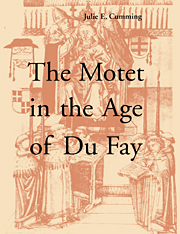Book contents
- Frontmatter
- Contents
- List of tables
- List of musical examples
- Acknowledgments
- Notes to the reader
- Introduction
- Part I Models and methods
- Part II Motets in the early fifteenth century: the case of Bologna Q15
- Part III Motets in the mid-fifteenth century: the case of the Trent Codices
- 8 Motets in the Trent Codices: establishing the boundaries
- 9 English and continental cantilena-style motets
- 10 Motets with a tenor cantus firmus c. 1430–1450
- 11 Freely composed four-voice writing in transition
- 12 The four-voice motet c. 1450–1475
- Conclusion
- Appendix: Widely disseminated motets
- Notes
- Bibliography of books and articles
- Modern editions of music
- Sources and sigla
- Notes on the index of works
- Abbreviations for subgenre identifications
- Index of works
- General index
12 - The four-voice motet c. 1450–1475
Published online by Cambridge University Press: 22 September 2009
- Frontmatter
- Contents
- List of tables
- List of musical examples
- Acknowledgments
- Notes to the reader
- Introduction
- Part I Models and methods
- Part II Motets in the early fifteenth century: the case of Bologna Q15
- Part III Motets in the mid-fifteenth century: the case of the Trent Codices
- 8 Motets in the Trent Codices: establishing the boundaries
- 9 English and continental cantilena-style motets
- 10 Motets with a tenor cantus firmus c. 1430–1450
- 11 Freely composed four-voice writing in transition
- 12 The four-voice motet c. 1450–1475
- Conclusion
- Appendix: Widely disseminated motets
- Notes
- Bibliography of books and articles
- Modern editions of music
- Sources and sigla
- Notes on the index of works
- Abbreviations for subgenre identifications
- Index of works
- General index
Summary
We will conclude our study of the motet in the fifteenth century with the different subgenres of four-voice motet copied between c. 1455 and 1475, concentrating on the motets in Trent 88, 89, and 91, but including also a few other motets from sources copied during the same period (see Tables 12.1–5). The later Trent Codices contain significant numbers of four-voice motets. Some are lingering remnants of earlier traditions: 89.590, O sacrum manna, is a double-discantus isorhythmic motet (see Table 10.1), while 88.347, Du Fay's O proles/O sidus, is a four-voice cut-circle motet also found in Trent 87 (see Table 11.2). Most, however, resemble the four-voice motets found in late fifteenth-century sources such as the Gaffurius codices or CS 15: they use the new Flos de spina and Caput textures, with a single discantus part and homogeneity of melodic style. We have traced some of the precedents for these new kinds of motet in chapters 10 and 11: it is in the later Trent Codices that substantial numbers first make their appearance. I will begin with a small group of four-voice song motets with a single section, and then go on to the large-scale multipartite motets that make up the bulk of the repertory.
Four-voice song motets
In Trent 89 and 91 there are a few four-voice pieces with a single section that resemble the three-voice Touront song motets and the contemporary repertory of four-voice chansons and instrumental works (see Table 12.1).
- Type
- Chapter
- Information
- The Motet in the Age of Du Fay , pp. 254 - 287Publisher: Cambridge University PressPrint publication year: 1999



